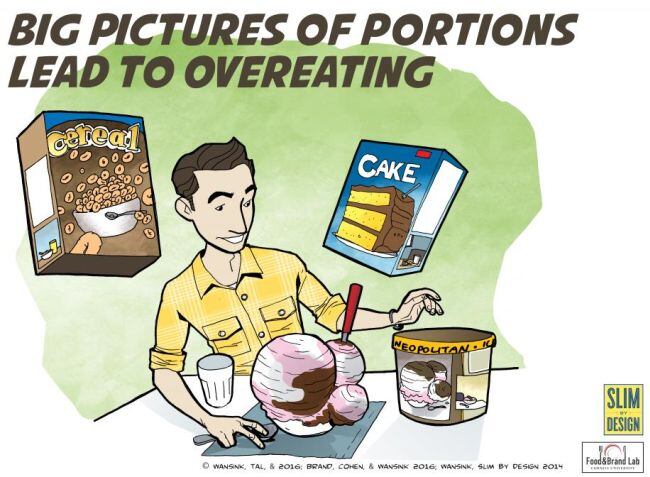Nothing good, according Cornell University Food and Brand Lab researchers, who discovered that portions depicted on the front of food packaging rarely correlate with the serving size listed on the Nutrition Facts panel at the back, and as a result, we’re consuming far more calories than we realize.
In some cases, the discrepancy arises because manufacturers like to depict products served with ‘extras’ (pancakes with maple syrup) to make them look more appealing, or as a helpful serving suggestion. But these extras are not included on the Nutrition label.
Cake mix boxes, for example, typically depict a slice of cake slathered in frosting to help us picture the end result.
What consumers may not realize, however, is that the Nutrition Facts panel only states the calories in the cake – not the frosting – so unless you’re planning to serve your cake minus the frosting, you need to cut a far smaller slice than that shown in the picture, said John Brand, PhD, lead author on the latest study coming out of Cornell's Food and Brand Lab.
Big disconnect between the picture and the serving size on the NF panel
Indeed, you might need to more than halve it, he said after revealing that depictions of frosted cake on 51 leading cake mix boxes contained on average, 134% more calories than the recommended serving size listed on the Nutrition Facts panel.
“If we see a slice of cake smothered in frosting on the cake box, we think that is what is normal to serve and eat, but that’s not what is reflected in the serving size recommendation on the nutrition label.”
In other cases, manufacturers are just depicting portion sizes that are way too big – regardless of the ‘extras’, said Dr Brand.

For example, ice cream containers display pictures of ice cream that contain, on average, 130% more calories than the serving size recommended on the back of pack, he said. And consumers are clearly taking their cues from the pictures, because those given boxes depicting bigger portions will routinely serve themselves more ice cream, he said.
Manufacturers should spell out what isn’t included on the Nutrition label
In the latest study, featuring 72 undergraduates and 44 female foodservice professionals, Brand et al found that even the foodservice professionals, a group of “nutritionally savvy and vigilant consumers” that had scrutinized the cake mix label, still served out portions of cake that contained 122 calories more per slice than the recommended serving size.
However, those shown boxes with labels explicitly stating that the frosting was not included on the Nutrition label, or shown boxes depicting cake without any frosting, were much better able to identify what an appropriate portion might be, noted Brand et al.
“The results are consistent with emerging literature demonstrating that a pictorial representation of products appearing on packaging affects serving size. To be less misleading, packaging should either not depict extras in its pictures or it should more boldly and clearly state that extras are not included in calorie counts.
“The results suggest that a more effective way to convey appropriate serving size information is to combine appropriate serving size depictions with a clear message about what is included on the nutritional labelling.”
*The study - Frosting on the cake: pictures on food packaging bias serving size - was published in the journal Public Health Nutrition: doi:10.1017/S1368980016000458 and self-funded by the Cornell Food and Brand Lab.
Watch the video below to find out more about the study:
